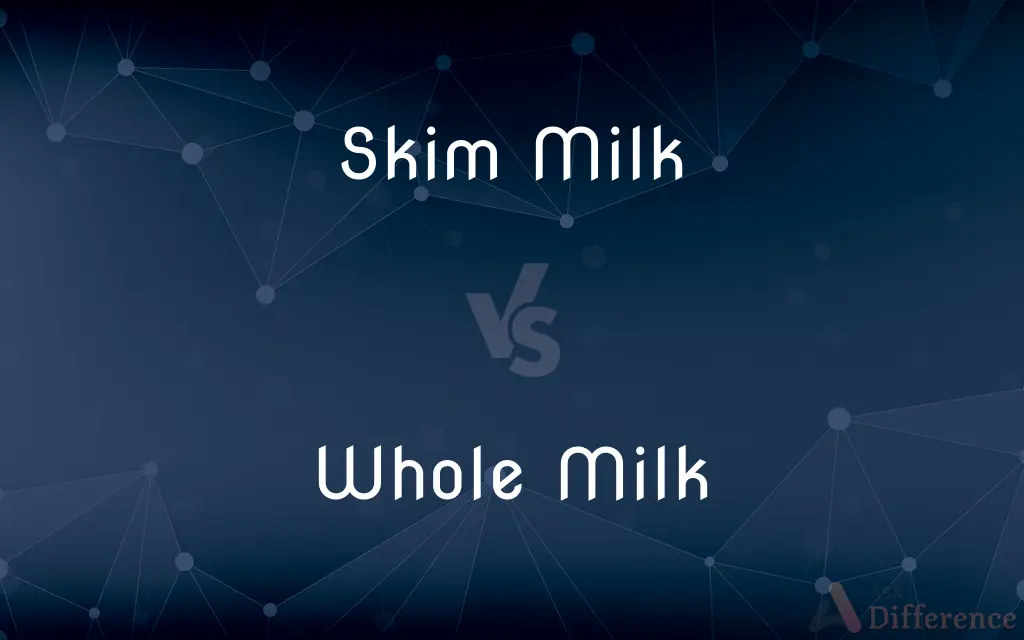Skim Milk vs. Whole Milk — What's the Difference?
By Tayyaba Rehman & Urooj Arif — Published on February 15, 2024
Skim Milk has had nearly all the fat removed, resulting in less calories and a lighter texture. Whole Milk retains all its natural fat, offering a richer taste and creamier texture.

Difference Between Skim Milk and Whole Milk
Table of Contents
ADVERTISEMENT
Key Differences
Skim Milk and Whole Milk are two popular choices among consumers, differing mainly in their fat content. Skim Milk, also known as non-fat milk, has had the fat content removed to less than 0.5%, making it a lower-calorie option compared to Whole Milk. This process not only reduces calories but also changes the milk's taste and texture, making it lighter and less creamy. Skim Milk is often chosen by those monitoring their calorie intake or following a low-fat diet.
Whole Milk, on the other hand, contains about 3.25% milk fat, which contributes to its rich flavor and creamy texture. The presence of fat enhances the absorption of fat-soluble vitamins present in the milk, such as Vitamins A and D. Whole Milk is preferred for its taste and nutritional benefits, particularly for children and those not restricted by calorie or fat intake considerations.
The choice between Skim and Whole Milk can also affect cooking and baking, where the fat content in Whole Milk can contribute to a richer flavor and moister texture in baked goods. Conversely, Skim Milk can be used to lighten recipes and is often used in coffee and tea for those seeking a lower-fat option.
In terms of nutritional content, both types of milk provide essential nutrients, including calcium, protein, and potassium. The main difference lies in their calorie and fat content, making Skim Milk a suitable option for weight management, while Whole Milk provides a beneficial source of dietary fats necessary for brain development and cell functions.
Both Skim and Whole Milk have their advantages and can fit into a balanced diet, depending on individual health goals, dietary preferences, and nutritional needs.
ADVERTISEMENT
Comparison Chart
Fat Content
Less than 0.5%
About 3.25%
Calories (per cup)
Lower
Higher
Texture
Lighter, less creamy
Richer, creamier
Taste
Less rich
More flavorful
Nutritional Benefits
Lower in calories, same protein and calcium
Contains dietary fats, fat-soluble vitamins
Compare with Definitions
Skim Milk
Suitable for low-fat dietary preferences.
Skim milk fits well into my low-fat eating plan.
Whole Milk
Preferred for its flavor and creaminess.
The creaminess of whole milk enhances the flavor of homemade ice cream.
Skim Milk
Often used to lighten coffee or tea.
A splash of skim milk lightens my coffee without adding many calories.
Whole Milk
Higher in calories and rich in dietary fats.
Whole milk is my choice for baking due to its creamy texture.
Skim Milk
Milk with nearly all fat removed.
I prefer skim milk in my morning cereal to cut down on fat.
Whole Milk
Essential for development in children.
Pediatricians often recommend whole milk for toddlers for its nutritional content.
Skim Milk
Lower in calories than whole milk.
Skim milk is a great choice for those on a calorie-restricted diet.
Whole Milk
Contains fat-soluble vitamins A and D.
I drink whole milk to ensure I'm getting enough Vitamin D.
Skim Milk
Retains essential nutrients despite fat removal.
Even without the fat, skim milk is rich in calcium and protein.
Whole Milk
Milk in its most natural state with full fat.
Whole milk gives my morning coffee a rich and creamy taste.
Common Curiosities
Is whole milk better for children than skim milk?
Yes, children benefit from the dietary fats in whole milk for growth and development.
Is skim milk more processed than whole milk?
Yes, skim milk undergoes an additional process to remove fat.
Do both types of milk contain the same amount of protein?
Yes, the protein content is generally the same in both skim and whole milk.
Which is better for weight loss, skim or whole milk?
Skim milk has fewer calories, making it a popular choice for weight loss.
Can drinking whole milk help with gaining muscle mass?
Yes, due to its higher calorie content and essential nutrients.
Is whole milk more expensive than skim milk?
Prices vary, but they are generally similar.
Can I substitute skim milk for whole milk in recipes?
Yes, but it may affect the richness and texture of the final product.
Does whole milk provide more calcium than skim milk?
No, the calcium content is similar in both, despite the fat difference.
Are there any taste differences between skim and whole milk?
Yes, whole milk is richer and creamier, while skim milk is lighter and less flavorful.
Which is better for heart health?
Skim milk is often recommended for those monitoring fat intake for heart health.
How does the removal of fat affect the vitamin content in skim milk?
Fat-soluble vitamins may be reduced, but skim milk is often fortified with vitamins A and D.
Can lactose-intolerant individuals consume skim and whole milk?
Both contain lactose, so lactose-free versions would be more suitable.
Which milk is better for making yogurt, skim or whole?
Whole milk is preferred for a creamier texture, but skim milk can also be used.
Does skim milk spoil faster than whole milk?
The spoilage rate is similar, depending on storage conditions.
Can I use whole milk instead of cream in recipes?
Yes, whole milk can be a lighter alternative to cream, though with less fat.
Share Your Discovery

Previous Comparison
Upright Vacuum vs. Canister Vacuum
Next Comparison
Digital Zoom vs. Optical ZoomAuthor Spotlight
Written by
Tayyaba RehmanTayyaba Rehman is a distinguished writer, currently serving as a primary contributor to askdifference.com. As a researcher in semantics and etymology, Tayyaba's passion for the complexity of languages and their distinctions has found a perfect home on the platform. Tayyaba delves into the intricacies of language, distinguishing between commonly confused words and phrases, thereby providing clarity for readers worldwide.
Co-written by
Urooj ArifUrooj is a skilled content writer at Ask Difference, known for her exceptional ability to simplify complex topics into engaging and informative content. With a passion for research and a flair for clear, concise writing, she consistently delivers articles that resonate with our diverse audience.
















































